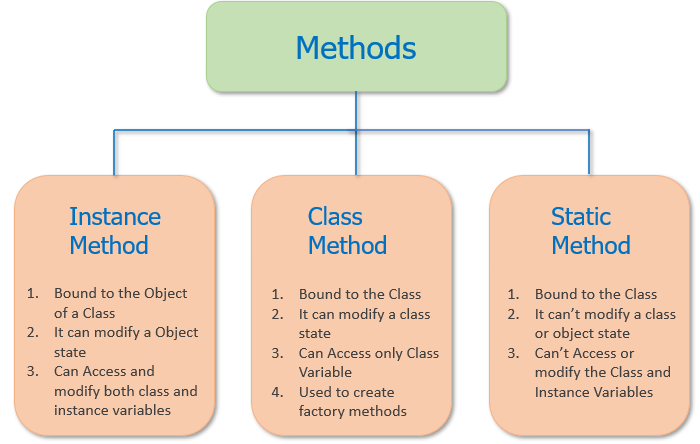In this tutorial, you’ll understand the difference between class method vs. static method vs. instance method step by step.
In Object-oriented programming, when we design a class, we use the following three methods
- Instance method performs a set of actions on the data/value provided by the instance variables. If we use instance variables inside a method, such methods are called instance methods.
- Class method is method that is called on the class itself, not on a specific object instance. Therefore, it belongs to a class level, and all class instances share a class method.
- Static method is a general utility method that performs a task in isolation. This method doesn’t have access to the instance and class variable.

Table of contents
Difference #1: Primary Use
- Class method Used to access or modify the class state. It can modify the class state by changing the value of a class variable that would apply across all the class objects.
- The instance method acts on an object’s attributes. It can modify the object state by changing the value of instance variables.
- Static methods have limited use because they don’t have access to the attributes of an object (instance variables) and class attributes (class variables). However, they can be helpful in utility such as conversion form one type to another.
Class methods are used as a factory method. Factory methods are those methods that return a class object for different use cases. For example, you need to do some pre-processing on the provided data before creating an object.
Read our separate tutorial on
Difference #2: Method Defination
Let’s learn how to define instance method, class method, and static method in a class. All three methods are defined in different ways.
- All three methods are defined inside a class, and it is pretty similar to defining a regular function.
- Any method we create in a class will automatically be created as an instance method. We must explicitly tell Python that it is a class method or static method.
- Use the
@classmethoddecorator or theclassmethod()function to define the class method - Use the
@staticmethoddecorator or thestaticmethod()function to define a static method.
Example:
- Use
selfas the first parameter in the instance method when defining it. Theselfparameter refers to the current object. - On the other hand, Use
clsas the first parameter in the class method when defining it. Theclsrefers to the class. - A static method doesn’t take instance or class as a parameter because they don’t have access to the instance variables and class variables.
As you can see in the example, in the instance
Difference #3: Method Call
- Class methods and static methods can be called using ClassName or by using a class object.
- The Instance method can be called only using the object of the class.
Example:
Output:
Jessa 12 ABC School School name changed to XYZ School School name changed to PQR School
Difference #4: Attribute Access
Both class and object have attributes. Class attributes include class variables, and object attributes include instance variables.
- The instance method can access both class level and object attributes. Therefore, It can modify the object state.
- Class methods can only access class level attributes. Therefore, It can modify the class state.
- A static method doesn’t have access to the class attribute and instance attributes. Therefore, it cannot modify the class or object state.
Example:
Output:
Student: Jessa 12
School: ABC School
Previous School name: ABC School
School name changed to XYZ School
Difference #5: Class Bound and Instance Bound
- An instance method is bound to the object, so we can access them using the object of the class.
- Class methods and static methods are bound to the class. So we should access them using the class name.
Example:
Do you know:
In Python, a separate copy of the instance methods will be created for every object.
Suppose you create five Student objects, then Python has to create five copies of the show() method (separate for each object). So it will consume more memory. On the other hand, the static method has only one copy per class.
Example:
Jessa 20 ABC School Jessa 20 XYZ School <bound method Student.change_School of <class '__main__.Student'>>
As you can see in the output, the change_School() method is bound to the class.
